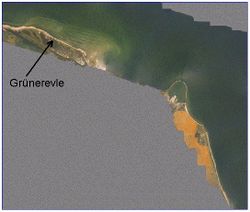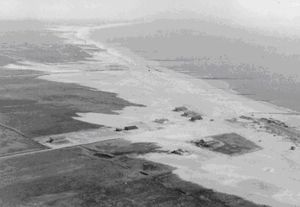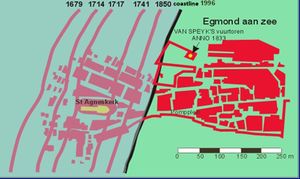Natural causes of coastal erosion
Natural coastal erosion of sandy coasts is caused by many factors which are shortly reviewed in this article. Coastal erosion may also result from man-induced activities. Erosion due to human interventions is described in e.g. Human causes of coastal erosion. Most of the content of this article is drawn from Mangor et al. 2017 [1].
Contents
Temporal erosion and ongoing erosion
An important notion for understanding coastal erosion refers to the concept of coastal sediment cell. A coastal sediment cell (also called littoral cell or sediment cell) is a coastal compartment that contains a complete cycle of sedimentation including sources, transport paths, and sinks. Erosion at one place in a coastal sediment cell implies accretion at another location within the same cell; the sediment distribution within the cell changes without affecting other coastal regions. A coastal sediment cell is in morphodynamic equilibrium if changes in the sediment distribution under the influence of fluctuating forcing (fluctuations in water levels, wave climate, including storms) have a temporal, quasi-cyclic character. Ongoing trends of erosion or accretion are excluded; ongoing erosion or accretion will finally lead to destruction or basic alteration of the coastal sediment cell. In practice there is always a net leakage of sediment from or to other coastal regions, but this can be a very slow process. So even though the coastal sediment cell is a theoretical concept, it can be very useful in practice for analysing and managing coastal erosion processes.
One example of a coastal sediment cell is a pocket beach enclosed between headlands, assuming absence of net offshore or onshore sand transport. The orientation of the beach can change in response to fluctuations in the dominant direction of incident waves. However, the resulting erosion and accretion have just a temporal character.
Another example of a coastal sediment cell refers to the concept of active coastal zone. The active coastal zone (sometimes also called active coastal profile) is the beach zone over which sand is exchanged in cross-shore direction by natural processes. The seaward limit corresponds to the closure depth and the landward limit to a hard boundary (seawall, cliff, ..). In the case of a dune coast the active zone comprises part of the front dune that can be eroded by storm waves (see Dune erosion). In the absence of net offshore or onshore sand transport and in the absence of gradients in littoral drift the active coastal zone is a one-dimensional sediment cell; the sediment volume in the active zone will be constant in time. Shoreline erosion and accretion in response to fluctuations in water level and wave climate (including storms) are temporal quasi-cyclic phenomena in this case, see Shoreline retreat and recovery.
An obvious example of ongoing erosion is cliff erosion. A coastal cliff eroded by wave attack will never be rebuilt by natural processes. Cliff erosion can be a fast process in case of soft cliffs (till, clay) and very slow in case of hard-rock cliffs. Other examples of ongoing natural erosion are given below.
Longshore sand loss due to transport gradients
One cause of ongoing natural coastal erosion is a longshore increase of sand transport: in this case more sand is leaving a coastal section than entering. As longshore sand transport (also called littoral drift) depends primarily on the direction and height of breaking waves, a gradient in longshore transport can be due to longshore varying wave conditions, coastline curvature, or nearshore bathymetric features. An example of this kind of coastal condition is the West Coast of Skaw Spit, the northernmost tip of Denmark. The presence of the headland and the port at Hirtshals, combined with the shadow effect of southern Norway, results in increasing transport along the section of coastline some kilometres east of Hirtshals to Gammel Skagen. For this reason the entire NW-oriented section of the Skaw spit is exposed to erosion.
Cross-shore sand loss
Sand loss from the active coastal zone in cross-shore direction can occur by different processes.
Breaching and over-wash
The loss of sand inland due to breaching and over-wash of a barrier island. This kind of sand loss takes place along the exposed coast of Skallingen barrier island on the southern part of the Danish North Sea coast, see Fig. 2.
Aeolian transport to the dunes
A wide vegetated dune area can trap fine sands carried inland from the beach by onshore winds. When the dunes along the Dutch coast were fixed by vegetation from the 16th century they started growing by capturing large amounts of sand. This contributed to fast shoreline retreat, illustrated in Fig. 3. The import of beach sand to the dune area at the Dutch is estimated at 5-35 [math]m^3/m/year[/math] [2] Assuming that this sand volume is withdrawn from the active zone (width of the order of 2 km, average slope of the order of 1/100), the resulting shoreline retreat can be estimated at 0.2-2 m/year.
Offshore sand loss under extreme wave and storm surge conditions
High energetic waves cause seaward migration of breaker bars and high storm surges further cause an offshore movement of sand due to non-equilibrium in the profile during the high surge. Sand that is transported sufficiently far offshore will not return to the coast by wave-induced onshore transport under a milder wave climate.
Offshore sand loss to canyons
If there is a deep canyon close to the shore, sand may be lost into the canyon by littoral drift.
Offshore transport at the tip of a sand spit
Sand can get lost by littoral drift into deep water at the tip of a sand spit forming the end point of a littoral cell. Sand lost in this way causes accumulative shore and shoal features in the deposition areas, at the expense of the downstream coast. An example of this is the Skaw Spit, see Fig.4.
Erosion downstream of accumulative forms

A similar process of natural coastal erosion occurs downstream of accumulative forms at coastlines with very oblique wave approach, coast types 4M, 4E, 5M and 5E. Along such coastlines there is a tendency for the natural formation of spits parallel to the coast. They accumulate the sand and shift the sand supply offshore, which means that the downstream coastline is starved and begins to erode, see Fig. 5.
Sand loss at coastal protrusions
The loss of material from a protruding area to one or two sides is a natural cause of coastal erosion. This typically happens at till/sandstone headlands, where fine eroded material is washed away by currents and coarse material is transported alongshore or offshore away from the headland. More generally, any semi-hard seaward-concave section of a coastline will suffer erosion in case of insufficient supply of sand from rivers. The natural state of such a coastline is erosion and straightening; the straightened coastline is referred to as a simplificated coast, see Fig. 6.
Marine deposit shorelines suspended between eroding headlands (till or sandstone, for example) will retreat similarly. The headlands have historically provided material for building up the sedimentary shorelines and the suspended shoreline is consequently dependent on the presence of the headlands. However, as the headlands continue to erode, the sedimentary shorelines will follow suit despite the fact that they were originally accumulative forms. This development is part of the simplificated coast (see previous paragraph).
Erosion also occurs at deltas coasts when the natural fluvial sand supply is reduced, depriving the delta protrusion from fluvial sand supply for its maintenance. This is generally caused by human interventions, see Human causes of coastal erosion, but it can also have natural causes. Droughts in large river basins can result in long periods with almost no sand supply to the shoreline, leading to shore erosion. The historic large variations in the shorelines of the Nile delta were partly due to this situation, whereas the more recent erosion is mainly the result of human interventions along the Nile. Natural shifts between distributary channels are another cause of delta erosion.
Climate change and sea-level rise
Climate change impacts
Climate change will impact on coastal erosion in different ways. Here the focus is on sea-level rise; other potential impacts are related to changes in meteorological conditions – wind, temperature and precipitation. Changes in the precipitation regime will affect the sediment discharge of rivers and the resulting sand supply to the coast. Extreme conditions of strong precipitation and long periods of drought are expected to become more frequent. Temperature may play a role too, by its impact on soil erosion. The influence of variations of fluvial sand supply to the coast were shortly discussed in the previous section. Change in temperature will affect all life forms in the coastal zone. Coastal erosion is particularly sensitive to changes in coastal vegetation, dune vegetation for example. Mangrove coasts are sensitive to temperature change, but also to sea-level rise, see Potential Impacts of Sea Level Rise on Mangroves. Change in the wind regime and wave climate will modify the alongshore and cross-shore sand distribution. The alongshore sand distribution is very sensitive to the littoral drift, which strongly depends on wave direction. The shape of the cross-shore coastal profile is strongly influenced by wave run-up, with an important role for storm events with high waves and water levels. Great uncertainty still exists regarding predictions for local changes in wind regime and wave climate caused by climate change.
Relative sea-level rise
The sea level will rise globally as a consequence of global warming, but regional differences are considerable. This holds in particular for relative sea-level rise, i.e. the change of sea level with respect to the local land level. Some coasts experience uplift (especially in previously glaciated regions) while others are subject to subsidence. Uplift can always be considered "natural", whereas subsidence often has an important human-induced component (groundwater, oil, gas extraction). According to the so-called "Bruun rule", an increasing relative sea level will cause a shoreline setback, which is approximately equal to the sea level rise divided by the average slope of the active coastal profile, when considering equilibrium profiles. Consider, for example, a sea level rise of 0.5 m and an equilibrium coastal profile with a slope of the shoreface and the shore of 1/100. The setback caused by such a sea level rise will be 50 m. Littoral coasts consisting of fine sediments will be exposed to higher setbacks than coasts consisting of coarser sediments.
Related articles
- Dealing with coastal erosion
- Erosion hotspots
- Coastal Hydrodynamics And Transport Processes
- Littoral drift and shoreline modelling
- Shoreline retreat and recovery
- Active coastal zone
- Shoreface profile
- Sea level rise
- Bruun rule
- Closure depth
Coastal erosion due to human intervention:
- Human causes of coastal erosion: an article on human-related factors causing coastal erosion.
- Accretion and erosion for different coastal types: Erosion caused by a large port for different types of coasts
- Port breakwaters and coastal erosion: Effects of breakwaters from different types of ports (isolated, river mouth in the sea, mouth of a large estuary) on coastal erosion
- Hard coastal protection structures: Explains the possible impacts of hard structures on the structural erosion of a stretch of coast
References
- ↑ Mangor, K., Drønen, N. K., Kaergaard, K.H. and Kristensen, N.E. 2017. Shoreline management guidelines. DHI https://www.dhigroup.com/marine-water/ebook-shoreline-management-guidelines
- ↑ De Vries, S., de Schipper, M., Stive, M., Ranasinghe, R. 2011. Sediment exchange between the sub-aqueous and sub-aerial coastal zones. Proceedings of the International Conference on Coastal Engineering 1 (32).
Please note that others may also have edited the contents of this article.
|




